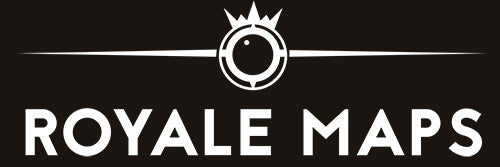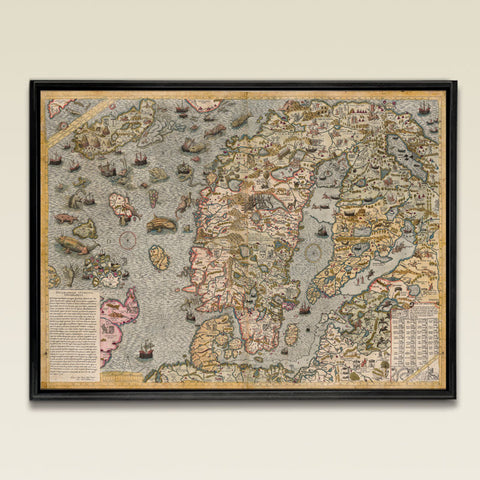Among the things that inspired us to create Royale Maps was the Carta Marina.
But what is the Carta Marina?
The Carta Marina is a map of Scandinavia. It was made in Rome by a man named Olaus Magnus. The Swedish Olaus Magnus was a Catholic ecclesiastic and a writer who is best known for his monumental work "A Description of the Northern Peoples".
The Carta Marina was printed in 1539 and stayed in print for twelve years. It was printed from nine wood panels and measures a huge 49 "x 67" (125 X 170cm).
Sadly, only two copies of this map still exist. One is kept in the Bavarian State Library in Munich and the other resides in the Uppsala University Library in Sweden.
Why all the monsters?
The truth is that Olaus Magnus intended to create an accurate gallery of marine biology based on the information collected from medieval bestiaries, popular folklore and mariner's accounts.
Olaus was so intent on being exact that he accompanied most creatures depicted with a written description. Reading these descriptions helps us better understand what Olaus meant to draw.
Which sea monsters are real?
THE SEA UNICORN

Olaus writes that the Unicorn is a sea beast with a very great horn on its forehead which can pierce the hull of ships and drown many men. He goes on to explain that the divine goodness made this creature very slow to protect the sailors against this beast. The Sea Unicorn is obviously a representation of the narwhal.

The narwhal is a porpoise found in Arctic coastal waters and rivers
THE SEA PIG

The description here is that the creature is a sea monster similar to a pig.
"Now I shall revive the memory of a monstrous Hog that was found afterward, Anno 1537, in the same German Ocean, and it was a Monster in every part of it. For it had a Hog's head, and a quarter of a Circle, like the Moon, in the hinder part of its head, four feet like a Dragon's, two eyes on both sides of his Loyns, and a third in his belly inkling toward his Navel; behind he had a Forked-Tail, like to other Fish commonly."

Olaus' sea pig is most probably a walrus.
THE ROCKAS

Olaus describes the Rockas as a friend of the swimming man, not a foe. The Rockas is said to protect men from being devoured by sea monsters. In his illustration, Olaus drew the Rockas picking off the fish and munching on the swimmer.
The Rockas is a representation of the ray.

The ray mostly lives on the sea bed and is a close relative to the shark.
THE SEA WORM

"He goes forward in the sea like a line, that he can hardly be perceived how he goes; he hurts no man unless he be crushed in a man's hand: for by the touch of his most tender skin, the fingers of one that toucheth him will swell." On the map, the Sea Worm is attacked by a giant crab. Olaus goes on to say that he often saw the Sea Worm with his own eyes but always refrained from touching the beast.
The Sea Worm is an eel.

The European eel can reach a length of 80 cm.
THE BALENA & ORCA

"A whale is a very great fish about one hundred or three hundred foot long, and the body is a vast magnitude; yet the orca, which is smaller in quantity, but more nimble in assault, and cruel to come on, is his deadly enemy.
An orca is like a hull turned inside outward; a beast with fierce teeth, with which, as with the stern of a ship, he rends the whale guts, and tears his calves body, or he quickly runs and drives him up and down with his prickly back, that makes him run to the fords, and shores."


Most sea monsters from the Carta Marina came from folklore.
THE SEA COW

The Sea Cow is a classic. It was a common medieval belief that every land animal had its counterpart in the sea. This belief can be observed through printed medieval bestiaries. Below are images from the ceiling paintings of the Church of St Martin in Zillis, Switzerland.

A sea chicken, sea elephant and sea bear, all panels from the ceiling of St Martin's Church. These date back to the 12th Century. These old beliefs still linger in the names of some marine animals today, such as the catfish and the starfish.
THE SEA SERPENT

"There is a sea serpent which is of a vast magnitude, namely 200 foot long, and more... He hath commonly hair hanging from his neck a cubit long, and sharp scales, and is black, and he hath flaming shining eyes. This snake disquiets the shippers, and he puts up his head on high like a pillar, and catcheth away men, and he devours them..."
Olaus Magnus' Sea Serpent is very similar to the Midgard Serpent, Jörmungandr, pictured below. In Norse mythology, Jörmungandr is the middle child of Loki and Angrboða.

Odin is said to have thrown Jörmungandr (the Midgard Serpent) into the sea where it grew large enough to encircle the Earth and eat his own tail.
CARIBDIS

"Hecest Horrenda Caribdis", reads the map, or "Here is the horror Caribdis".
Caribdis, or Charybdis, was a sea monster in Greek mythology. Famously featured in Homer's Odyssey, Charybdis was said to live under a rock, opposite Scylla, another sea monster. The idiom "to be between Charybdis and Scylla", meaning having to choose between to evils, stems from there. Depending on the story, Charybdis was either a monster or a whirlpool that consumed entire ships.
THE SEA RHINOCEROS

Unlike the other sea monsters on Olaus' map, the rhino monster dining on lobster is not named in his key and only gets a very brief description: "A monster looking like a rhinoceros devours a lobster which is 12 feet long." This could suggest that Olaus had a space to fill and chose to let his imagination run free. A little improvisation perhaps.
This ends our tour of the monsters that inhabit the grandiose Carta Marina. The Carta Marina has inspired many other cartographers to add creatures on their maps, as shown below. What's more is that the Carta Marina has not aged one bit. It still inspires us today.
This Islandia map by Abraham Ortelius ca. 1590was heavily inspired by the Carta Marina.
Catherine x




